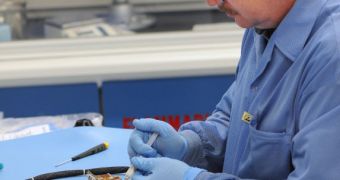Officials at the NASA Goddard Space Flight Center (GSFC), in Greenbelt, Maryland, announce the completion of two magnetometers that will go on the American space agency's Mars Atmosphere And Volatile EvolutioN (MAVEN) spacecraft.
The purpose of the two flux gate magnetometers will be to measure the intensity of the magnetic field wherever the orbiter may be. They will thus enable scientists to create a map of the magnetic environment surrounding the Red Planet.
These devices will be a part of the Particles and Fields Package suite on MAVEN. They were recently sent to the Space Sciences Laboratory, at the University of California in Berkeley (UCB), where the integration process is being conducted.
The PFPs are basically magnetometer sensors whose main role will be to understand how the Martian atmosphere is interacting with solar winds, and how particles are escaping into space. Both these processes are determined by the planet's magnetic field.
In order to avoid any potential interference from the electronics aboard the spacecraft, the instrument is placed at the ends of MAVEN's solar arrays. This will ensure that they take the most accurate readings possible.
“The team worked hard and completed delivery of the magnetometers on schedule. We are looking forward to launch, orbit insertion and seeing the data come back,” NASA GSFC Magnetometer Instrument Lead, Jack Connerney, explains.
“The geometry of the magnetic field determines where particles go to and where they come from. If we want to understand particle motion, we need to visualize how the magnetic field behaves throughout the Mars environment,” the expert goes on to say.
MAVEN's primary mission will be to paint a more detailed picture of the upper portions of the Martian atmosphere. Scientists suspect that the planet once had vast volumes of gases surrounding it, but that most of these chemicals were eventually lost into space. They plan to figure out how this happened.
The spacecraft is scheduled to launch in late 2013, NASA officials say. Throughout its missions, the satellite will provide an in-depth view of the Red Planet's climate history, which will help experts understand how Mars changed from a watery world to the deserted wasteland it is today.
“The magnetometer is the first of the science instruments to be completed and delivered. It’s really exciting to see the payload now starting to come together,” University of Colorado in Boulder (UCB) Laboratory for Atmospheric and Space Physics (CU/LASP) expert Bruce Jakosky says.
“This is an important milestone in our path toward getting to Mars and using our measurements to answer questions about the history of the Martian atmosphere,” adds the scientist, who is the principal investigator of the MAVEN mission.

 14 DAY TRIAL //
14 DAY TRIAL //